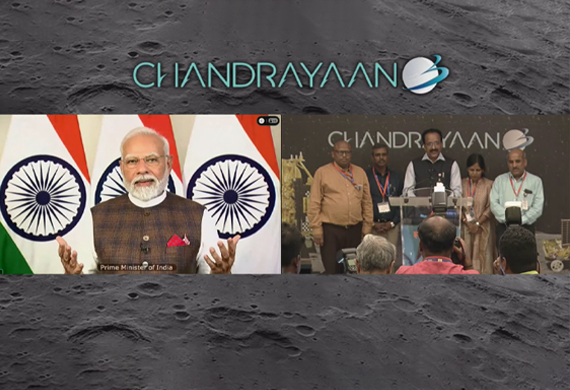
ISRO's Chandrayaan-3 Makes Historic Lunar Landing Near the South Pole
By: WE Staff | Wednesday, 23 August 2023
India's third lunar mission, Chandrayaan-3, has successfully landed near the moon's south pole region, making India the first country to achieve this feat.
The mission, which was launched on 14 July 2023, consists of a lander named Vikram and a rover named Pragyan, similar to those of the Chandrayaan-2 mission. The lander and rover are expected to explore the lunar south pole region, which is considered to be rich in water ice, and other resources that could support a human base on the moon.
A milestone for India's space program
Chandrayaan-3 is a matter of national pride and scientific achievement for India, as it showcases the country's growing space ambitions and capabilities. The mission has a price tag of $74.6m far lower than those of other countries, in keeping with India’s frugal space engineering. The mission has received support and appreciation from various political leaders, celebrities, and citizens of India, who have expressed their excitement and confidence in ISRO's capabilities.
The mission is also a testament to India's resilience and perseverance, as it comes after the partial failure of Chandrayaan-2 in 2019 when the lander Vikram lost contact with ISRO during the final descent and crashed on the lunar surface. ISRO did not give up on its lunar dreams and decided to launch Chandrayaan-3 with a similar configuration but with improved design and performance.
The mission is also a part of India's long-term vision for space exploration, as it plans to launch more missions in the future, such as Gaganyaan (human spaceflight), Aditya-L1 (solar research), and Shukrayaan-1 (Venus orbiter).
A challenging and complex landing
The landing of Chandrayaan-3 was one of the most challenging and complex operations ever attempted by ISRO. The lander had to perform a series of maneuvers to reduce its speed and altitude from the lunar orbit to the landing site near the south pole region. The powered descent was scheduled for 23 August 2023, around 05:45 pm IST and touchdown was expected on the same day around 06:04 pm IST.
The landing site was chosen after careful analysis of high-resolution images and data from Chandrayaan-2's orbiter, which is still functioning around the moon. The site was located in a relatively flat area between two craters, Manzinus C and Simpelius N, at a latitude of about 70 degrees south. The site was also chosen to maximize the sunlight exposure for the lander and rover, which rely on solar power for their operations.
The landing was executed autonomously by the lander's onboard computer, which had to deal with various uncertainties and challenges such as communication delays, lunar gravity variations, terrain hazards, dust clouds, and thermal effects. The lander had four throttleable engines that provided thrust and attitude control during the descent. The lander also had a laser altimeter, an accelerometer, a gyroscope, and a camera to measure its position, velocity, orientation, and altitude.
The landing was monitored by ISRO's Mission Operations Complex (MOX) in Bengaluru, where hundreds of scientists and engineers were anxiously watching the live telemetry data from the lander. The landing was also broadcast live on various media platforms, where millions of people across India and the world eagerly followed the historic event.
A Scientific Exploration of the Lunar South Pole
The main objective of Chandrayaan-3 is to demonstrate a soft landing on the moon and explore the lunar south pole region, which is considered to be one of the most intriguing and promising areas for future lunar exploration. The region is believed to contain water ice and other resources that could support a human base on the moon. The region also offers unique scientific opportunities to study the origin and evolution of the moon and its relation to Earth.
The lander and rover are expected to operate for at least 14 Earth days, which is equivalent to one lunar day. The lander and rover will communicate with each other and with the orbiter, which will relay the data to Earth. The orbiter will also perform its scientific observations using its eight instruments, which include cameras, spectrometers, radars, and a mass analyzer.
A Remarkable Achievement of Women Scientists
Chandrayaan-3 is not only a remarkable achievement of India's space program, but also a remarkable achievement of women scientists who have played a vital role in the mission.
Dr. Muthayya Vanitha, the project director of Chandrayaan-3, is responsible for the overall management and coordination of the mission. She is the first woman project director of an Indian interplanetary mission. She has been working with ISRO for over three decades and has been involved in various satellite and lunar missions.
Dr. Ritu Karidhal is the mission director of Chandrayaan-3 and is responsible for the planning and execution of the mission operations. She is also known as the "Rocket Woman" of India. She has been working with ISRO for over two decades and has been involved in various launch vehicle and lunar missions.
Apart from these two women leaders, many other women scientists have contributed to various aspects of the mission, such as engineering, testing, simulation, analysis, communication, and outreach.
A Proud Moment for India & The World
The successful landing of Chandrayaan-3 near the lunar south pole is a proud moment for India and the world, as it marks a new milestone in the history of lunar exploration. The mission has shown that India is capable of achieving challenging and complex missions with its indigenous technology and innovation. The mission has also shown that India is committed to advancing the scientific knowledge and exploration of the moon for the benefit of humanity.
The mission has received congratulatory messages from various national and international leaders, organizations, and celebrities, who have praised India's achievement and expressed their admiration and support for ISRO's endeavors. The mission has also received overwhelming appreciation and applause from the people of India, who have celebrated the success of the mission with joy and pride.
Chandrayaan-3 is a historic lunar landing that will be remembered for generations to come. It is a shining example of India's scientific prowess and space ambition. It is a glorious chapter in India's space odyssey.






